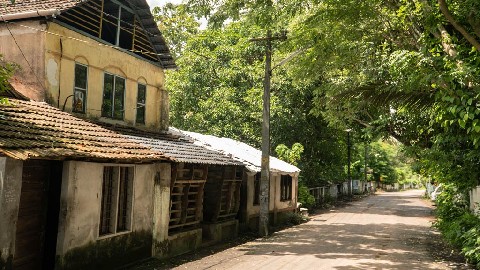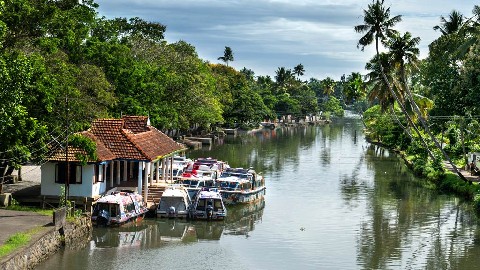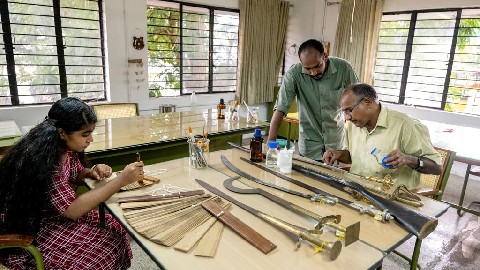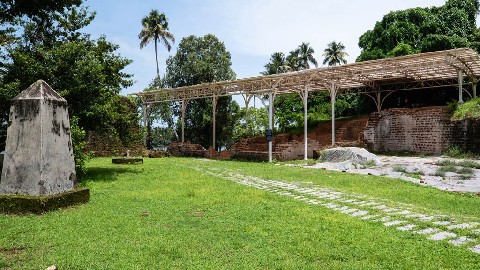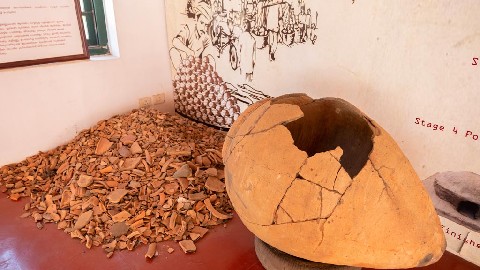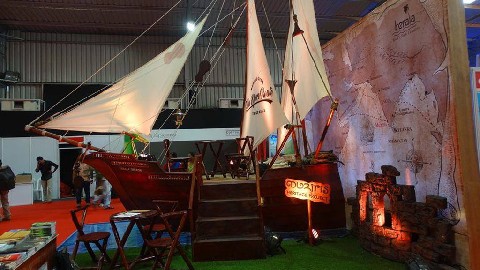Muziris Heritage Conservation Project
The Muziris Heritage is mind-boggling in the sheer range and grandeur of a period of history it attempts to recreate. Like a time capsule, it takes tourists, history/culture enthusiasts, researchers and connoisseurs alike to a world that was linked by shared interests in trade, religions and cultures. The Muziris Heritage Site conjures up a bygone era and ethos that Muziris embodied, by taking the present generation to the shores where St Thomas first arrived in order to spread Christianity in India; the first mosque which resounded with the Muslim call for prayers; the Bhagavathy temples where animal sacrifices once prevailed; the Jewish synagogues where Hebrew prayers were chanted; the old palaces and royal residences within whose walls edicts were issued, treaties signed, and stratagems plotted – in all their recreated splendour.
The Muziris Heritage Project aims to revive popular interest in a region which lost its glory centuries ago. Through the project, we will be able to travel back in time to a place where vibrant cultures of the East and the West met, and see the palaces of Prime Ministers of the erstwhile kingdom of Cochin, the forts built by the Portuguese that played strategic roles in wars, the Indo-Dutch architectural structures along the streets and the places where various cultures thrived through the centuries. In short, it will give us glimpses of a magnificent past.
The Government of Kerala initiated the Muziris Heritage Project to reinstate the historical and cultural significance of the legendary port of Muziris. The region is dotted with numerous monuments of a bygone era that conjure up a vast and vivid past. The entire project is designed to involve and integrate the local community in all its intended developmental initiatives. The preservation-cum-tourism project of Muziris also provides timeline tours, culture tours, museum tours, backwater cruises, etc.
Muziris Region
The Muziris Heritage Site (MHS) stretches from the municipality of North Paravur in Ernakulam district to Kodungallur in adjoining Thrissur district. It includes four panchayats in Ernakulam district, viz. Chendamangalam, Chittattukara, Vadakkekkara and Pallippuram, and three panchayats in Thrissur district, viz. Eriyad, Mathikalam and Sreenarayanapuram.
The Muziris region undertaken for conservation by the Muziris Heritage Project encompasses monuments, archaeological sites and the very landscape, all of which illustrate a significant era in the history of Kerala. While the design of the Muziris Heritage Site has been greatly influenced by its natural environment, the project has judiciously exploited these resources in order to underscore the uniqueness of the historical period it seeks to re-animate for the sake of the future generations. For instance, the network of waterways has inspired a tourist circuit that gives a panoramic view of the entire region.
Features and Objectives
Muziris Heritage Project is an important undertaking by the Government of Kerala towards holistic conservation of a rich and proud history. The Features and Objectives of the project are as follows:
Features
- This is the largest heritage conservation project ever undertaken in India
- This is the first project of the Government of Kerala to follow the Green Protocol
- It involves the co-ordinated effort of multiple Government departments
- More than 25 museums have been set up to help visitors appreciate the Muziris Heritage
- A research and academic institution has been established in order to support the project
- Major infrastructural improvements have been brought in so as to make the Project a valuable asset to the state and the nation
- Integration with local communities, through the agency of native resource persons for the purpose of data collection, survey, etc., was ensured
Objectives
- To promote awareness and understanding of the cultural distinctiveness and diversity of Muziris
- To conserve cultural assets and safeguard them for the present and future generations
- To practise and promote sustainable development
- To promote a participative approach towards conservation and restoration
- To ensure accessibility for all
- To include the heritage of Muziris in regional educational programmes
- To undertake heritage management as a means to promote communal harmony
Conservation Lab
To conserve and preserve history even while retaining its past glory is no simple task. Muziris, a heritage packed town and abode of such exquisite history, makes the job even more challenging.
While dealing with an artefact, it is of the utmost importance that we be aware of the ‘age of the object’. The object conserved is documented at each phase – before, during and after restoration. The two main processes involved in conservation are Preventive conservation and Curative conservation. In Preventive conservation, the reasons behind the cause of deterioration – that may vary from climatic fluctuations to factors like humidity, temperature, pollution, natural calamities, etc. – are carefully examined. Curative conservation deals with treating the object with appropriate chemicals and other substances to restore it to its original chemical and physical strength.
The Muziris Conservation Lab headed by Shri M. Narayana Namboothiri, an art restorer with more than 30 years of expertise in the industry, strives primarily to attain this possibility, while obeying every rule of the art of restoration. The office, with facilities for restoration processes, functions at North Paravur. The identity of the object, the materials it is made of and how it is made are the initial and the most significant criteria taken into consideration.
During the floods that severely affected Kerala in 2018, many artefacts were damaged in the Muziris region as well. On requisition from Paliam tharavad, the Muziris Conservation Lab collected 29 palm leaves which were in highly dilapidated condition. Preventive conservation that involved the removal of mud, separation of leaves from damp conditions, etc. was done immediately at a Lab situated at Pullut. They were all later shifted to a new Lab at Paravur on 23 September. Out of these, 12 palm leaves have already been scientifically conserved using appropriate methods that followed photographic documentation in each step. Conservation is not a mere beautification procedure, as the process aims to completely recapture the original physical and chemical strength of the artefact.
Preventive restoration is always considered better than Curative restoration. Curative restoration becomes the last option, if it is found that the artefact will not to survive unless there is an intervention of chemicals and other structural repairs. Anything beyond restoration is left to science and modern technology rather than to any experimental approaches, as conservation science keeps evolving.
The Story of Conservation
The conservation of historic buildings, their preservation along with development, and informal dissemination of information are the prime concerns of the Muziris Heritage Project. The monuments and sites in the Muziris region are physical reminders of history, and indicators of the diversity of cultures and traditions that the ancient port city once enjoyed. The Muziris Heritage Project is thus the story of tangible and intangible elements that created this ancient hub of world sea trade.
The uniqueness of the Muziris project is that it is designed in such a way as to involve and integrate the local community in all its intended initiatives. Through appropriate activities contributing to the social and economic development of the region as well as ensuring an enhanced quality of life, the project maintains a balance between development and conservation.
Muziris Heritage Project
The Muziris Heritage Project is one of the biggest conservation projects in India, where the state and the central governments have come together, with support from the UNESCO, to conserve a rich culture that is 3000 years old or more. Since 2016, 19 departments of the state government have been working together on the project, collaborating with various national and international agencies, and ensuring proper documentation and research in all areas.
The region that forms a part of the heritage project lies between North Paravur in Ernakulam district and Kodungallur in Thrissur district and stretches across twelve panchayats and two municipalities.
The shrines, forts, palaces, seminaries, cemeteries, boatyards and markets, spread over the whole area that have deep connections with the history of the state, will be preserved and conserved. Further, by showcasing the traditional crafts patronized during that time and the markets that were in existence, the exhibits in the heritage museums will throw considerable light on the life of the people, and thereby illustrate a significant era in the history of Kerala. Various performing arts, that represent the non-physical aspect of the land’s history and the culture of the Muziris region, are also under the process of conservation.
As part of the initial phase of the project, eight museums have been opened to the public. The already functional museums in Muziris are examples of restoration work that has been able to retain their heritage significance. In its initial phase, the list of buildings to be restored included a diverse mix of heritage sites. But that was a daunting task because numerous challenges and threats – from delayed maintenance to damage wrought by natural causes – slowed down the momentum of the project.
Recognizing the need to safeguard the natural environment for the benefit of present and future generations, the project has thereafter succeeded in operating within the tourism sector, while fully embracing the principles of heritage conservation. Preserved through conservation processes, they have become viable platforms capable of achieving the targeted goals of sustainable development and inter-cultural dialogues. While the reconstruction of this old port city gives us precious peeks into its long-forgotten history and culture, it also inspires us to revere its past glory, observable in both tangible and intangible forms.
Two archaeological sites, Pattanam and Kottappuram, where archaeological excavations and explorations are being undertaken, are the keys that open to the hoary past, and unlock the many mysteries that have intrigued archaeologists and historians alike. Many artefacts of interest have been unearthed that throw light on the historical times and cultural mores of the legendary port of Muziris.
Today, the recreated Muziris is a place that disseminates information about a long-forgotten past, and initiates various non-formal educational activities for students of all age groups. This is the only place that offers a live and continuous learning platform for an understanding of a segment of Kerala history, as Pattanam excavations continue to unearth valuable vestiges of the past that offer glimpses of the lives of our ancestors.
Excavations So Far
Muziris holds the unique distinction of having yielded a complete human skeleton for the first time in India, from the Kottappuram Fort area. Some of the other items excavated from here include Chinese coins, Chinese inscriptions, pieces of decorated porcelain, West Arabian pottery pieces, iron nails, bullets, stone beads, 17th century Dutch coins and tiles, all of which will be set up in the museums.
Pattanam Excavation
The significance of Pattanam, a town close to Kodungallur and North Paravur in Kerala, cannot ever be overstated. Excavations in the area, undertaken by the Kerala Council for Historical Research (KCHR), have unearthed certain remains of a lost culture, and archaeologists are positive that they constitute incontrovertible evidence of a long dysfunctional port. Valuable pieces of amphoras [ancient Greek jars or vases with large oval bodies, narrow cylindrical necks and two large handles that rise up to their mouths], semi-precious stones like carnelian, beryl and stones that are blue, green and red in colour are indicators of a trading culture of those times.
Pattanam also is the site from where a small boat, five to six metres long, was recovered from four metres below ground level. Burial sites which carry remains of cremated bodies, like pieces of bone, and objects of daily use have also been found here. The large number of Roman artefacts – particularly small gold coins from a place named Valluvally – unearthed from the site serve as evidence of the extensive maritime contacts that this region had with Rome during the early historic period.
Kottappuram Excavation
The excavation carried out in the Kottappuram area has unearthed a Portuguese fort and numerous other remnants of past cultures. The Kottappuram Fort, also known as Kodungallur Fort, was built in 1523. Chinese wares, red slip ware, other pottery artefacts and iron objects are also included in the list of Kottappuram findings.
Excavations
The two main excavation sites that provided invaluable evidences for the port of Muziris were Kottappuram and Pattanam. Read more about the significance of the regions and the artefacts unearthed.
Kottappuram Fort
At the first glance, the Kottappuram Fort may not look very impressive to the modern eye. Located right at the mouth of the Periyar, it appears to be nothing more than a set of dilapidated thick walls, overrun by creepers and inscribed over with graffiti. But there was a time when the structure was truly formidable, held promise of great power and prestige, and was the bone of contention among many powers, native and foreign. Built in 1523 by the Portuguese, it stands to the north of Pallippuram Fort. It had bastions fitted with guns, housed military barracks, bungalows and also places of worship. In 1662, the fort was witness to a struggle for control between the Zamorin [ruler of Calicut] and the Dutch. The next year the Portuguese withdrew their claim on the fort. Eventually the Dutch seized control of this fort but they set out to destroy the existing structure and build another on the same site. By 1670 the new one was completed. Later, Marthanada Varma who ruled the princely state of Travancore from 1729 till his death in 1758, bought this fort from the Dutch. However, in 1790, in the course of an invasion by the ruler of the kingdom of Mysore, Tipu Sultan, the fort was conquered and destroyed. In the end, when the British defeated Tipu Sultan, Travancore got the fort back. But by then, all the buildings were in ruins. The fort was reduced to a few walls here and there, with a few run-down bastions in between. It lay thus in a state of ruin until the Muziris Heritage Project took it under their wing.
The process of excavation began with clearing the entire fortification area. Certain structural remains were found in the process. Two walls, one at the northern end and other at the centre of the fortification area, were identified along with two bastions and an arched cellar. Quadrants were used with the intention of tracing out submerged structural remains and levelling the entire fortification area as well. Further excavation in the trenches mainly revealed a few flights of steps, a massive laterite wall, mud rammed floor, etc. Major artefacts that were unearthed included coins, door hinges, clamps, cannon balls made of stone and iron, different types of nails, etc. Roof tiles, bricks with non-indigenous character and square-shaped floor tiles were also uncovered during the excavation.
The excavated fort at Kottappuram is soon expected to turn into a happening site museum.
Pattanam Excavation
Pattanam was a modest, quiet and nondescript town in Ernakulam district until recently. However, it became what the renowned historian Romila Thapar described as "a turning point for studies into India’s maritime relations" when excavations in the area unearthed evidences of an advanced civilization in a bygone era. As the assorted pieces of a gigantic historical jigsaw puzzle began to form a recognizable pattern, historians were able to reconstruct the story of a land that had long-time and deep connections with peoples and cultures from far-flung areas of the globe, as far back in time as 2,000 years back.
The Pattanam excavation is the first ever multi-disciplinary excavation to be undertaken in Kerala. The excavation is aimed at unearthing archaeological evidence, which will help to locate/identify an early historic urban settlement and the ancient Indo-Roman port of Muziris or Musiri on the Malabar coast.
The site at Pattanam extends to approximately 1.5 sq. kms and the core area measures about 600 x 400 m. The north-eastern part of the site was chosen for excavation based on the surface exploration undertaken earlier. The ‘locus methodology’ adopted for this excavation helped distinguish each layer/feature/pit/structure/activity area on the basis of colour, texture and composition.
Many important finds were obtained like human bones, storage jars, a gold ornament, glass beads, stone beads, utility objects made of stone, copper and iron, typical pottery, early Chera coins, brick wall, brick platform, ring well, wharf with bollards and a six-meter long wooden canoe parallel to the wharf structure about 2.5 m below the surface.
The structures indicate a vast ‘urban’ settlement. The excavations suggest that the site was first occupied by the indigenous Megalithic (Iron Age) people, followed by the Roman contact in the early historic period. It appears that the site was continually occupied from 2nd century BCE to 10th century CE. The maritime contacts of this region during the early historic period seem to have been extensive as evidenced by a large number of Roman amphora shreds, a few terra sigillata shreds, Sassanian Yemenite and other West Asian potteries. The sheer number of roulette ware probably made in the Bengal-Gangetic region signifies the site’s importance in the pan Indian context as well.
The Spice Route Initiative
The Spice Route that connected the East with the West had a defining moment in history when the Portuguese explorer Vasco da Gama made his eventful journey to Malabar. It opened the doors to a new world, laid the foundation for colonization, and caused the rise and fall of mighty empires. Traversed by explorers and traders of yore, the Spice Route proves to be one of history’s most significant and enigmatic trade routes.
Along the historic Spice Route, several places emerged as bustling centres of trade including the ancient port of Muziris and some of today’s tourist hotspots like Fort Kochi and Kozhikode. These spots stood witness to civilizations being shaped, wars being fought, vast riches being exchanged and history being rewritten. Historical records reveal that 31 countries in Europe, Asia and the Far East conducted spice trade with ancient Kerala. This included Afghanistan, Burma, China, Denmark, Egypt, Jordan, Lebanon, Malaysia, Mozambique, Netherlands, Oman, Portugal and Spain. A journey along the Spice Route is a journey to rediscover some of history’s magnificent phases.
When Kerala emerged as a major centre of spice trade, it was the ancient port of Muziris that established itself as its hub. Texts belonging to Sangam literature describe Roman ships laden with gold arriving at the shore of Muziris, to be exchanged for pepper. According to the first-century annals of Pliny the Elder and the author of Periplus of the Erythrean Sea, Muziris could be reached in 40 days from the Red Sea ports in Egyptian coast, depending entirely on the monsoon winds. However, tragedy struck in 1341, when the profile of the water bodies in the Periyar river basin on the Malabar coast underwent a major transformation, and Muziris dropped off the map due to floods and earthquake. However, the remnants of the port and its erstwhile glory still remain as reminders of an eventful past. They are being conserved and preserved for future generations through one of India’s largest conservation projects – the Muziris Heritage Project. Supplementing the Muziris Heritage sites are 22 museums and other landmarks that aim to educate people about 2000 years of Kerala history.
The project is also supported by UNESCO, and it hopes to retrace the trade links of Kerala with foreign countries and promote the culture and heritage of the land. More than a tourism initiative, the project aims to facilitate an effective exchange of knowledge and create an intercultural space.
